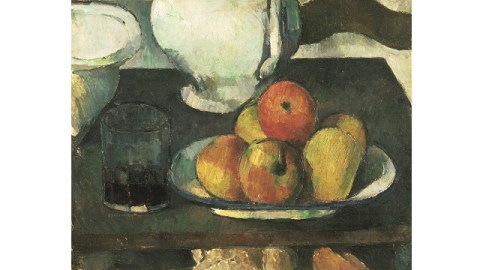How Cézanne Saw a World in an Apple

Just as poet William Blake asks us “To see a world in a grain of sand” in his poem “Auguries of Innocence,” painter Paul Cézanne asks us to see the world in an apple in the many still lifes that span his long career. In The World Is an Apple: The Still Lifes of Paul Cézanne currently at the Barnes Foundation in Philadelphia, PA, we’re invited to enter into the world of “the painter of apples” and come away with new eyes that see what Cézanne called the “ambient penetration” of all things, that living quality of even inanimate objects best captured in the still life, or as the French would say, “Nature morte,” literally and paradoxically “dead life.” Using one of the oldest of genres, Cézanne set the rules for the modern art that followed him while forging a naïve, simplistic persona the real philosopher in paint hid behind. After viewing The World Is an Apple, you’ll come away with a new appreciation not only of Cézanne the painter, but also of Cézanne the visionary who saw the whole world in even the simplest apple and wants you to, too.
Cézanne worked slowly. His deliberation during painting became legendary. Human subjects suffered long hours before his easel. The suffering of Madame Cézanne in portraits of her is almost laughably palpable. For practical reasons, inanimate objects—apples, pottery, skulls, mountains—provided much better subjects. As Dr. Benedict Leca, curator of the exhibition and Director of Curatorial Affairs at the Art Gallery of Hamilton, writes in the introduction to the show’s catalog, “Cézanne believed in the inner life of everyday objects ‘which disperse themselves naturally in and around each other through intimate reflections, just as us through our gazes and words.’” Things talk to each other, Cézanne believed, and he wanted to capture that conversation in his painting, especially in still lifes.
For example, in Still Life with Fruit and Glass of Wine (Nature morte avec fruits et verre de vin) (painted 1877-1879; shown above), the rounded lip of the glass as well as the bulbous shapes of the pottery in the rear “talk” to the plumpness of the fruit. Although the fruit glows brightly yellow and orange, the touches of green converse with the green touches of the otherwise white pitcher, bowl, and plate. Meanwhile the warmer colors of the fruit make them pop out of the picture as the cooler grays and browns of the table recede in the background, creating the illusion of movement. In a fascinating catalog discussion of the neurological, psychological, and even philosophical connections of Cézanne’s use of color, Paul Smith explains how this “modulation” of color “can (among other things) make the substantiality of objects visible.” Elsewhere, Leca calls Cézanne’s use of color a “sort of imagined transubstantiation” reflecting the artist’s “peculiar animist worldview in which people, the natural environment, and both living and inanimate things were seen by him as interconnected agents operating against the fabric of his life.” Like the Eucharistic transubstantiation of Cézanne’s Roman Catholicism in which bread and wine become body and blood, in Cézanne’s still lifes apples and vases become the people and places he loved. When Cézanne penciled a self-portrait beside an apple, you can see how he saw a similarity between even his own bulging, brainy forehead and the fruit.
As Adam and Eve discovered, the apple was the fruit of the Tree of Knowledge. Cézanne turned the apple and its central role in his still lifes into his own delivery system of knowledge, specifically that knowledge about himself and his goals he cultivated for public consumption. Leca stresses Cézanne’s self-fashioning via still life throughout his catalog essay. “Comprised of chosen objects of personal significance pre-arranged and in turn deliberately painted,” Leca explains, “still lifes provided [Cézanne] multiple stages through which to construct a constellation of meanings around himself.” Still lifes become collections of “artifacts of the self” for Cézanne, Leca argues, “that could image Cézanne’s remembered past and at the same time narrate the journey of his artistic self-discovery.” A devout student of art and the science of seeing, Cézanne nevertheless cast himself as a naïve artisan in rustic clothing who painted more by natural intuition than by hard-earned intellect. In her catalog essay, Nina Athanassoglou-Kallmeyer points out that all of Cézanne’s still life props “are products of the [artist’s native Aix-en-Provence] region’s artisanal making,” just as “the stark simplicity” of his studio embodied the “artist’s stalwart ethos” in contrast to the lavish studios of his more establishment artist contemporaries in Paris. Similarly, Richard Shiff muses on the moral world of these still lifes in which the subject and the artist’s purity stand out as even Cézanne’s signature marking style took on (perhaps unintentionally) “a moral dimension” in opposition to the authority of the old ways. Young guns such as artist Maurice Denis elevated Cézanne to hero status. Denis’ painting Homage to Cézanne tellingly focuses not on the hero himself but rather on one of his still lifes, the subject of passionate discussion among a flock of admiring artists.
This small exhibition also focuses tightly on the still lifes gathered from various museum collections and private hands. Although small, the show is quite powerful, with the enlightening wall text pointing out the interplay of colors and shapes so that you can crack Cézanne’s code for yourself. You’ll find yourself looking at the paintings, reading the text, looking again for the connections, and then looking even longer to make more connections between the contents of one work as well as between the different works. For example, I’ve seen Cézanne’s The Artist’s Father, Reading “L’Événement” countless times, but I’ve never made note of the still life hanging over the artist’s father’s shoulder. Seeing in the show that very same still life, painted in 1866, at the very beginning of Cézanne’s career, I recognize Cézanne’s inclusion of it in the portrait to be just as challenging and self-proclaiming as the placing of the liberal “L’Événement” in his conservative father’s hands. I also spent a long time looking at Cézanne’s late Vase of Flowers, in which he paints a real vase of flowers on a flower-covered carpet before a mirror reflecting the real and fictional flowers—an overabundant flowering of effects leaving you mesmerized not just by the shapes but also by the almost bubbling surface of heavily applied paint threatening to froth out of the frame. After a pair of beautifully rendered skull still lifes in oil—in which the apples of life magically transform into symbols of death before your eyes—the show closes with a heartbreaking watercolor of a skull nestled in flowered drapery, a juxtaposition of ponderous death balanced against the lightness of vegetating life that shouldn’t make sense but in Cézanne’s world beautifully does.
I’ll confess to minor annoyance at having to leave the exhibition room to seek and find through the Barnes Foundation’s permanent collection—arranged in the idiosyncratic manner of its namesake founder—the 16 more Cézanne still lifes that are part of their 69 total works by the master. I quickly kicked myself after happily falling into the “trap” the Barnes had set, either intentionally or unintentionally. Looking at the Cézannes in situ, in their rightful place in the current of art history, it dawned upon me that not only is the world an apple, but the whole world of modern art is a Cézanne. Picasso and Matisse are both credited with calling Cézanne “the father of us all,” but you don’t get the full sense of that patriarchy until you see a Cézanne still life beside a Van Gogh landscape in which the earth crackles with the same undulating energy of a tablecloth in one of Cézanne still lifes. Looking at the luscious flesh of one of the Barnes many Renoir nudes, I imagined the apples finally rolling off Cézanne’s tables and springing into expansive female life. I only wish that The World Is an Apple: The Still Lifes of Paul Cézanne could take the Barnes’ collection along with it on the road to give more people the enlightening experience the Philadelphia combination provides.
“Why do we divide the world?” Cézanne once asked a friend. “There are days when the universe appears to me as one single flow, an aerial river of reflections; of reflections dancing around man’s ideas.” In a discussion with Dr. Leca, he stressed to me Cézanne’s modernity in his nonstop, restless, almost multitasking approach to capturing the truth of what’s before our eyes, however fleeting. After some reflection, I’d add that Cézanne’s strikingly modern also in the sense of his personal “internet” of existence—an almost manic hyperlinking of present and past, inert and active, alive and dead—in which no individual is ever truly alone. After looking at The World Is an Apple: The Still Lifes of Paul Cézanne, you’ll never look at an apple (or a still life, or a Cézanne) in the same way ever again.
[Image:Paul Cézanne, Still Life with Fruit and Glass of Wine (Nature morte avec fruits et verre de vin), 1877-1879, oil on canvas, 10 1/2 x 12 7/8 inches, Philadelphia Museum of Art, 1950-134-32.]
[Many thanks to the Barnes Foundation for providing me with the image above from, a copy of the catalog to, and a press pass to view The World Is an Apple: The Still Lifes of Paul Cézanne, which runs through September 22, 2014.]





